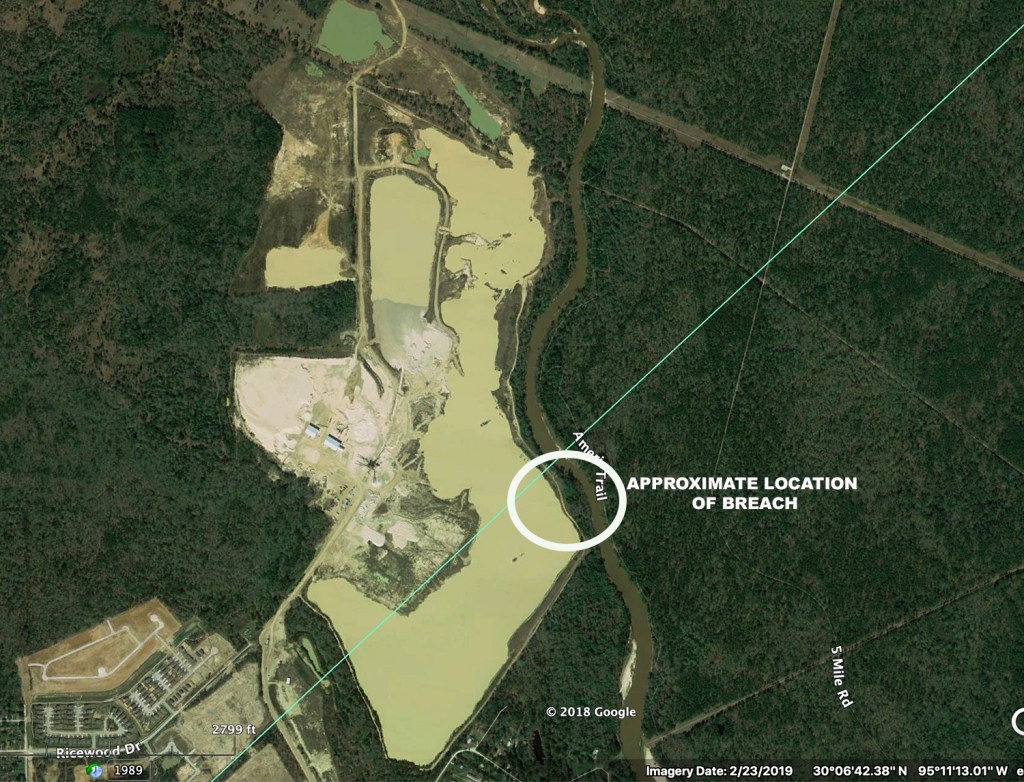Nailed: Triple-P Sand Mine Photographed Discharging Wastewater Directly into Lake Houston Tributary
Since Harvey, I’ve been talking about the dangers of sand mining too close to the river. Texas is the only state I can find that has no minimum setback for mines. Tony Buzbee, candidate for Mayor of Houston, asked to see what I was talking about. So a friend, Josh Alberson, took us on out his jet boat this afternoon.
Massive Breach in Mine Dike
As luck would have it, we went up Caney Creek. Just above where it enters the East Fork, we spotted a massive new breach in the dike of the Triple-P mine. Here’s what we saw.







Mine Has History of Problems
I previously posted about breaches in this mine’s dikes and the loss of a major portion of its stockpile during Harvey. The stockpile is located in the confluence of two floodways (Caney Creek and White Oak Creek). Partially as a result of this mine, Kingwood’s East End Park just downstream was inundated with sand and gravel up to 15 feet deep after Harvey. Repairing damage to the trails in the park cost Kingwood residents almost $200,000. The wetlands have been lost forever.

The Triple-P mine also receives very favorable treatment from the Montgomery County appraisal district. They tax most of it as though it were timberland.
Buzbee as Witness
If you are a sand miner, having Tony Buzbee witness this breach and the massive sedimentation it caused downstream is a nightmare scenario. Not only is Buzbee running for Mayor of Houston, he’s self-funding his campaign. That means he does not depend on TACA contributions. And worse (or better if you are a resident), he’s one of the top litigators in the world. In 2015, he was named Texas lawyer of the year. Kingwood residents can only hope he takes up this cause.
TCEQ Already Investigating
Upon returning home from the boat trip, I immediately notified Ramiro Garcia, head of Compliance and Enforcement for the TCEQ (Texas Commission on Environmental Quality) about the breach in the dike. Garcia says they have people already on the case. I hope they choose to yank this mine’s license and make it an example. At a minimum, I believe they should give the mine the maximum fine. My understanding is that the fine can run up to $25,000 per day. This kind of flagrant violation endangers the health of millions of people and deserves no less.
A water quality expert I talked to about breaches like this told me they spike chloride levels in Lake Houston. Chlorides, you may remember, caused the pipe corrosion in Flint, Michigan, that contributed to pipe corrosion, lead poisoning, a public health crisis and an erosion of trust in local government.
Revive Best Practices Legislation for Sand Mines
As a result of the problems created by sand mining in the San Jacinto River watershed, State Representative Dan Huberty sponsored a bill this year to establish best practices for the mines. HB 909 was referred to the Environmental Regulation Committee on 2/25. The committee heard testimony on 5/1. TACA testified AGAINST establishing and publishing best practices. HB909 has been bottled up in committee ever since.
Please use this breach to try to get the legislation out of committee. This is major. It affects the drinking water supply for 2 million people. I talked about the dangers of mining too close to rivers when I testified for HB909. These miners just don’t care. They think that their ability to make a profit is more important that your health. Please send a message to Austin. Refer the members of the Environmental Regulation Committee to this post and tell them this is what Rehak testified about on 5/1. Have them vote it out of committee. Let’s establish best practices for sand mining in Texas. While we still can.
Here are the members of the Environmental Regulation Committee.
- J.M. Lozano (Chairman) (512) 463-0463
- Ed Thompson (Vice Chair) (512) 463-0707
- Cesar Blanco (512) 463-0622
- Kyle Kacal (512) 463-0412
- John Kuempel (512) 463-0602
- Geanie Morrison (512) 463-0456
- Ron Reynolds (512) 463-0494
- John Turner (512) 463-0576
- Erin Zwiener (512) 463-0647
Please call their office and ask them to vote HB 909 out of committee. Tell them this breach is the great example of why we need this bill. Breaches like this happen far too often. There are only ten days left in this session.
Posted by Bob Rehak on 5/18/19, with a big thank you to Josh Alberson and Tony Buzbee
627 Days since Hurricane Harvey
All thoughts expressed in this post represent my opinions on matters of public policy and are protected by the First Amendment of the US Constitution and the Anti-SLAPP statute of the Great State of Texas.










